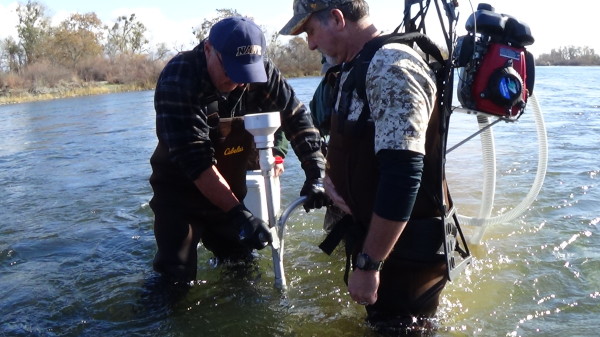CDFW Injects 20,000 Salmon Eggs Into Feather River

The following press release is courtesy of the Golden Gate Salmon Association:
San Francisco — After two years of working with the Golden Gate Salmon Association (GGSA), California Department of Fish and Wildlife biologists injected 20,000 fertilized salmon eggs into Feather River gravel in a historic first for California. The eggs, from the Feather River hatchery, were injected December 4th as part of an experiment to see how many will hatch and to give state workers experience using egg injection technology.
“Egg injection could provide a powerful tool to offset future salmon losses caused by drought,” said GGSA executive director John McManus.
Egg injection has been used in Alaska and Oregon in work going back decades. GGSA science consultant Dave Vogel brought the idea to GGSA in 2014 when rivers heated to levels lethal to salmon eggs. GGSA then asked the state to consider a massive egg injection program to offset the expected losses and avoid low returns of adult salmon in 2017, but the egg injection didn’t happen. GGSA kept asking and in 2015 the state agreed to do a small pilot project to test the equipment and determine manpower needs and to find out what percentage of the eggs would successfully hatch.
In nature, incubating salmon eggs, buried in underwater river gravels die when water temperatures exceed 56 degrees, something common during these last few years of drought. In drought conditions, salmon eggs could instead be collected, fertilized, chilled, and temporarily held in hatcheries. After rivers cool in late November and December, the incubating eggs can be gently buried in river gravel where they’ll continue incubating for another month or so before hatching. Unlike fish hatched and raised in hatcheries, salmon from injected eggs don’t require the feeding and physical infrastructure hatchery reared fish need.
Fine mesh nets will be affixed atop the injection sites to trap the emerging fry prior to expected hatch in January. They’ll be counted to determine what percentage of eggs hatched. In nature, an estimated ten to 40 percent of salmon eggs hatch. Up to 90 percent of injected eggs have reportedly hatched in best cases.
In addition to mitigating for salmon lost to drought-warmed rivers, egg injection could be used to offset other types of losses. One possibility; to offset future winter run losses from late spawning fish. This could allow water managers to switch from high summer flows to lower fall flows in the upper Sacramento River earlier to avoid the massive loss of fall run eggs that occurs in many years when reservoir releases are sharply curtailed after the majority of the fall run eggs are in the gravel. When this happens, millions of fall run eggs go from being under water to being high and dry which kills them.
“Combined with state of the art DNA analysis currently used to select salmon for breeding at a few advanced hatcheries, injecting high quality, non-hatchery, eggs could reduce harm to wild stocks in the next drought,” said McManus
Goldengatesalmon.org
(855) 251-GGSA (4472)




